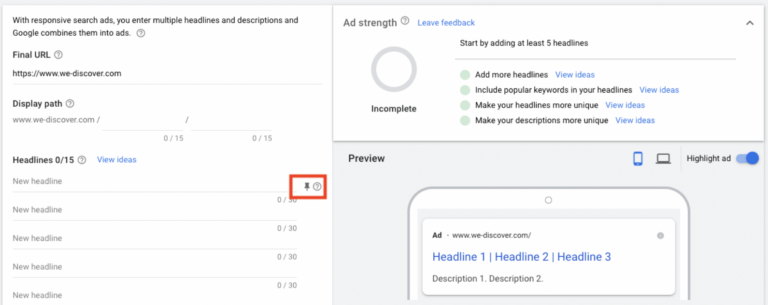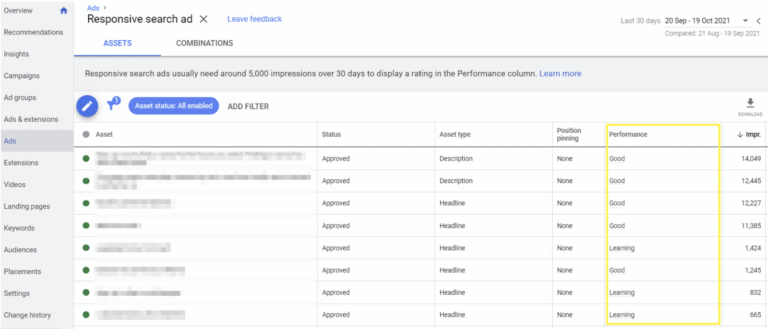Ad Copy Testing: Prioritisation Framework
Ad Copy Testing: Prioritisation Framework
Overview
How do you create good, long-term account improvements through tests and experiments? For us it comes down to 3 factors:
-
- Understanding your product, understanding your customers and creating hypotheses on how to connect the two
- Designing new variants (tests) that have the highest chance of improving account performance
- Driving the largest possible gains from those new variants
The challenge of course, is then trying to create as many ‘winning’ tests as possible. A common process for creating a new ad copy test often looks something like:
-
- Draft ad copy variants
- Share them with your client/team/manager
- Select one that is expected to perform best
- Launch the test
The problem with this process is that it can be highly subjective. It leaves your testing strategy open to all sorts of natural bias that people develop over time. Of course there are some benefits to heuristic analysis done by experts, but the challenge comes in scaling that ability.
We wanted to use a framework that was more robust; one that removed as much subjectivity as possible, and added experimentation rigor into the process. That is why we have created the Ad Copy Testing Prioritisation Framework.
You can make a copy here.

Within this structure we have asked a range of questions about a given test hypothesis and ad copy that, once answered, transform into a score per hypothesis. You can then use this to rank all of your testing options.
This will:
-
- Give your test hypotheses more objective ratings (allowing the test with the highest chance of success to rank first)
- Develop a culture that is structured by making informed decisions driven by data
- Allow you to create ad copy tests that have a higher probability of being successful
The structure of RSAs
You should aim to have one RSA per ad group in your account. To find any existing ad groups in your account that don’t currently do this (and to set up notifications for if this happens in the future), add our RSA checker script to your account. You can find details on how this works and a link to the script in this article.
When it comes to constructing your RSAs, the main components align with ETAs. You must include headlines, description lines, a final URL and may enter optional paths. Where ETAs and RSAs diverge, is on the number of these entities a single ad can contain, and how they are shown by Google.
In a single RSA you have space to supply 15 unique headlines, though you need only include a minimum of 3. You also have space for 4 unique description lines but, like ETAs, RSAs require 2 as a minimum.
The RSA preview tab (in the Ad Copy Testing Prioritisation Framework) is a useful tool for viewing how your RSA copy will show. Look at the sections below for more information on that, and pinning headlines and description lines in place.
The order you input your headlines and description lines in a RSA has no bearing on how the actual ad will show. Google will, over time, automatically test different combinations that all the entities can show in. If there are particular entities, or combinations of entities, that do not perform well, Google will automatically limit how often they show over time. This means that on balance there’s more benefit to including as many ad copy assets as possible, as your spend with poorly performing ones will be limited.
Don’t worry if you don’t think all of your assets are perfect. Ensure they fit at least some of the framework criteria outlined in the sheet (you can also use ad copy that you are already using in your ETAs) and then test them to get learnings on something that does/doesn’t work. The more headlines and description lines there are provided, the more combinations there can be available to test. This also increases the options available for Google to choose from when trying to show the most relevant copy possible. Ultimately then, the more testing options available; the more data available to help find optimum winning ad copy combinations.
Pinning RSAs (use sparingly!)
As discussed above, all headline and description line assets you provide could potentially be shown by Google in any order. While Google should learn if there are any combinations that don’t work particularly well together – and therefore limit how much they show – you should still ensure that any combination you could show makes sense.
Pinning a headline or description line means that it will always show in the pinned position you have selected within a given RSA. If you want to ensure that a specific entity always remains in a certain place, for example if you always want headline 1 to be the same, you may pin it in place when you set up your copy within Google Ads. You can do this by clicking on the pin to the right of your headline in the setup screen, highlighted in the screenshot below.

Be mindful though that doing this will reduce the number of possible combinations that your ad can show, thus limiting the amount of data you can collect. That is why we’d generally recommend aiming to avoid pinning a single entity where possible, though it can be a particularly useful tool for companies operating in regulated industries, where you may need to include a disclaimer in your ad copy. To ensure you’re adhering to advertising guidelines in the country you’re showing ads in, take a look at this list of advertising codes.
If pinning is something you’d like to utilise, you can try pinning more than one entity to the same place. For example, you may pin headlines 5, 6 and 7 all to the headline 1 spot. In this way, you ensure that some specific copy always occupies your headline 1 position, but you still allow flexibility for Google to test a number of ad copy combinations.
The prioritisation framework
Within the framework some questions are weighted differently to reflect their importance. The key questions with the highest weightings are:
-
- Is the hypothesis based on customer research?
- Is the search query in the headline?
- Does the ad copy address something unique (when compared to the other ads or organic results)?
- Do the landing page and the ad copy reference the same USPs to increase relevance?
We then include a series of further questions that enquire about certain factors we frequently see driving strong engagement within ad copy. You can adapt the Test Prioritisation Framework to your needs though; it is designed to be highly customisable. If there is a factor you believe to be important, we urge you to incorporate it within your own framework by creating further columns.
Once you have worked through the questions you will receive a score for your asset/variant hypothesis. From that you can create a ranking list and logic based order for your upcoming ad copy tests.
Preview tab
You can use the ad copy preview tab to write in new proposed RSA copy. In order to see some of the ways that your copy will be stitched together, make use of our RSA preview tool in the tab. Clicking the “generate preview” button will randomly pull together various combinations for you to review. This can be a helpful tool in checking that various iterations of your different assets work together.

Evaluating results
To look at the performance of individual headlines and description lines within a single RSA, open the ad and click “view asset details”, as shown in the screenshot below.

When sufficient data has been collected to reach a conclusion (around 5,000 impressions over 30 days), the performance column will rank performance of each asset according to a low, good or best categorisation. If an asset hasn’t yet collected enough data for Google to provide ranking information, you will see a note showing that it is unrated, in learning or pending. You can take a look at the number of impressions an asset has seen to gauge:
-
- How long it might take to get ranking information on it
- How much data has been used to give an asset a ranking. The more impressions it has received, the more confident you can be of the result

Once you have visibility on the performance of an asset, use it to inform next steps, by replacing low performing entities with new ones that are more similar to your best ones.
Testing
For any ad copy tests that you are able to apply labels to, you can use our Experimentation Studio to measure their performance on a statistically significant level to determine how and when to make decisions about launching the next round of testing. Find more information here.
This framework was created to help build a culture of continuous testing whilst removing subjectivity when choosing your next test. We would love to know how it impacts your prioritisation efforts. Please let us know through our contact us page.

